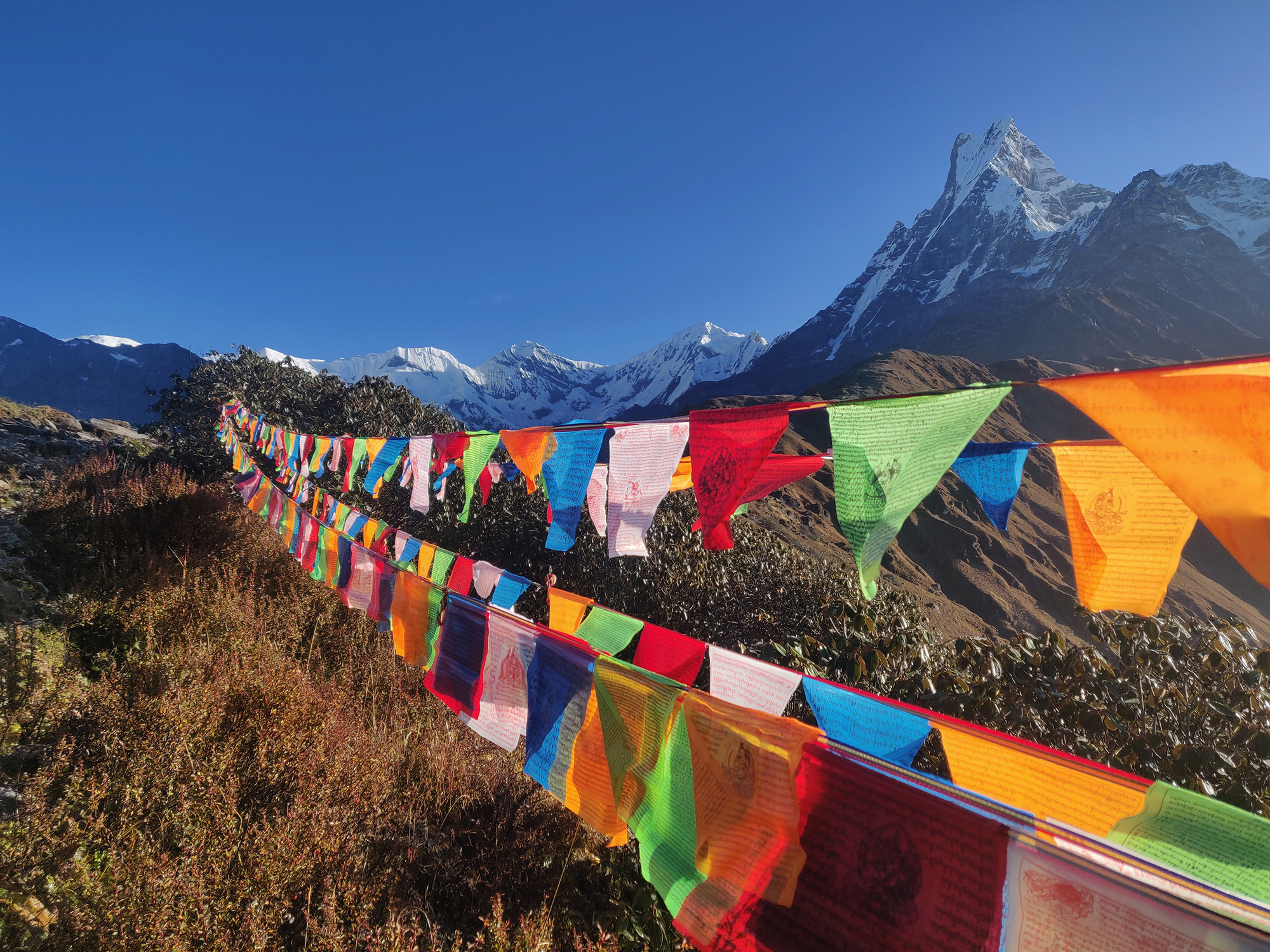Trip Overview
Discover the Allure of the Annapurna Base Camp Trek
Embark on an unforgettable journey through the heart of Nepal’s majestic Himalayas with the Annapurna Base Camp (ABC) Trek. Known as one of Nepal’s most beloved treks, this expedition takes you to the base of the iconic Annapurna I (8091m) and offers a breathtaking immersion into the stunning landscapes of the Annapurna Sanctuary.
Starting Point: Nayapul to Pokhara
Your adventure begins at Nayapul, a short and scenic drive from the picturesque city of Pokhara. As you travel along the highway, you’ll be treated to awe-inspiring views of the Annapurna range and landmarks such as the Peace Stupa. This drive sets the stage for the natural beauty and cultural richness that await you on the trek.
A Diverse Tapestry of Experiences
Also known as the Annapurna Sanctuary Trek, this expedition offers a rich variety of experiences. You’ll traverse lowlands, hillside villages, majestic waterfalls, pristine streams, and rejuvenating hot springs. The trail leads you through terraced rice fields and stone steps, presenting challenges like the steep ascents of Ulleri, Shinwa, and Chhomrong.
Enchanting Forest Trails and Wildlife
As you progress, you’ll find yourself immersed in enchanting forest trails adorned with bamboo and rhododendron. These forests are home to diverse wildlife, including monkeys, blue sheep, and the elusive red panda. The trek offers a panoramic spectacle, ranging from terraced rice fields to glacier moraines and towering peaks.
Majestic Mountain Views
The Annapurna Base Camp Trek provides unparalleled views of some of the highest peaks in the world. Marvel at the grandeur of Machhapuchhre (6993m), Annapurna I (8091m), Annapurna South (7219m), and Hiuchuli (6441m). The vantage point at Poon Hill is particularly spectacular, offering a sunrise view of Mt. Dhaulagiri (8167m) that is simply breathtaking.
During the rainy season, the sight of shepherds herding their flocks on the grassy ridges near the base camp adds a unique charm to the landscape.
A Week in the Himalayas
The journey to Annapurna Base Camp spans over a week, allowing ample time to acclimatize and soak in the serene mountain environment. The trek is moderately challenging, requiring good physical fitness, but the rewards are immense. Every step brings new vistas and experiences, culminating in the awe-inspiring Annapurna Base Camp at 4,130 meters (13,550 feet).
Return to Pokhara and Kathmandu
After reaching the base camp, the trek concludes with a return to the charming city of Pokhara. Here, you can relax and explore the lakeside beauty of Phewa Lake, with the Barahi Temple at its center—a site frequented by Hindu pilgrims. Pokhara also offers additional attractions like the International Mountain Museum, the Gorkha Museum, and the mesmerizing Seti Gorge.
Enhance Your Experience
To complement your trekking adventure, consider exploring the vibrant cultural and natural sights of Pokhara. The serene ambiance of Phewa Lake, the rich history displayed in the museums, and the stunning natural formations like Seti Gorge add depth to your Annapurna experience.
Embark on an Unforgettable Adventure
The Annapurna Base Camp Trek is more than just a hike; it’s a journey through some of the world’s most spectacular landscapes and rich cultural settings. From terraced fields and dense forests to towering peaks and serene lakes, every step of this trek reveals the magic of Nepal’s natural wonders. Whether you’re a seasoned trekker or a novice adventurer, the ABC Trek promises a once-in-a-lifetime experience that will leave you with lasting memories and a deep appreciation for the beauty of the Himalayas.
Tour Highlight
- Picturesque view of Mountains and Himalayan Valleys
- Beautiful Pokhara Sightseeing
- Awesome view of Poon Hill
- Typical Gurung Village in Ghandruk
- Natural Hot Spring Jhinu
- Exploring the Fishtail Base Camp
Trip Facts
Trip Itinerary Expand All
Arrival at Tribhuwan International Airport
Welcome to Nepal! We will receive you the airport and transport you to hotel.
Pre-trip meeting and sightseeing around Kathmandu valley
The day beings with a meeting and introducing with your trek and tour leader. After breakfast, we organize a short meeting at the hotel lobby. The meeting finalizes the preparation of the trek. In the meeting, you need to bring three copies of passport copy size photos, and travel insurance copy. Soon, the day tour will starts and on the tour visit most highlighted places of Kathmandu.
PASHUPATINATH TEMPLE
Pashupatinath Temple is one of the most visited and sacred places of Hindu. According to Hindu mythology, Pashupatinath is one of four Dham. It is not only a religious place also the cremation place. The dead body is burning with firewood in the bank of holy river Bagmati.
BOUDDHA STUPA
Bouddhanath Stupa is one of the biggest Buddhist shrines in the world. While touring in Buddha you can meet the monks, learn Buddhism, gather the information about Thankas, and its significants.
BHAKTAPUR DURBAR SQUARE
Bhaktapur Durbar Square is a royal palace built in centuries ago when Nepal had 22 and 24 state kingdom. The palace is famous with the name of fifty-five windows durbar, Nyatapol Mandir the tallest temple in Nepal. The Lion Gate, Golden Gates, The statue of King BhupatindraMalla and the pottery where the potter makes are the main attractions of Bhaktapur.After finished the tour, the evening time is to review the luggage for the trek. If you interested you can walk around Thamel, choose the restaurant for dinner.
Drive to Pokhara (900m) by tourist bus -7 hrs
This is quite an exciting day for trekkers because, after breakfast, we reach the bus station for a drive to the scenic lakeside city of Pokhara. The drive is about 7 hours and goes through the scenic countryside of central Nepal. We stop for lunch at Gunadi at around 11:30 am and reach Pokhara in another 2 hours. Pokhara is a holiday city and looking at the lakes, hills, and mountains, it is no wonder why it is so well known. A wide panorama of the Annapurna range is clearly visible from the city, most notably Machhapuchare (Fishtail mountain) that prominently overlooks Pokhara. Dhaulagiri, Annapurna, Lamjung Himal, and Manaslu also tower above.
Drive to Nayapul (1,010m) - 1.5 hrs and Trek to Tikhedhunga (1,570m)
After 1.5 hour drive from Pokhara, you reach Nayapul then short trek through the bank of the river of Modi Khola to get to Birethanti, a large village with teahouses and shops. When you reach Ramghai, we stop for lunch. After lunch, the trails continue to the north along the banks of Bhurungdi Khola. Then steadily up the trails we head to the north to reach Tikhehdunga, at an altitude of 1570m. We stop here for the day and check into a guesthouse.
Trek to Ghorepani(2,840m)
After a steep climb to Ulleri at the start of the day, the most difficult part of the trek will be behind us. Ulleri is a large village of Magar ethnic group that lies at an altitude of 2070m. Now the walking path gradually ascends from the point to Banthanti through the oaks and rhododendrons forest. Banthati is a place for lunch where you reach in 3.5 hrs from Tikhedhunga. Trail heads up to Ghorepani (2840m) via Nangethanti (2460).
Hike up to Poon Hill (3,210m); and trek to Tadapani (2,610m)
Get up early in the morning to hike up to Poon Hill (3210m). The stunning sunrise view over the mountains is really worth all the effort and waking up early. After spending about an hour on the hill, we head to Tadapani. The first climb takes us to Deurali, which boasts amazing view of Ghorepani against a backdrop of Dhaulagiri and Annapurna, we start heading down to Tadapani, with some uphills and downhills along the way through dense forests.
Trek to Sinwa (2340m)
We walk further down from Tadapani through rhododendron forests to reach the Gurung village of Chhomrong at an elevation of 2,170m and set along the slope of a giant hill. We will stop here for lunch, after which we go down to Chhomrong Khola and make a small ascent to Sinuwa (2340m).
Trek to Himalaya (2840m)
Today you will slightly climb through the rhododendron village via Kuldi Ghar (2470m). Now the trek enters Upper Modi Valley from where you can see Bamboo and Dovan below. Beyond the Dovan the trail crosses a stream then climbs up across the landslide. The climb passes a temple decorated with Shiva Trident and flowers. From there in twenty minutes later you will reach deep gorge at Himalayan Hotel.
Trek to Annapurna Base Camp (4,130m)
The day begins with a climb through the forest of bamboo and rhododendron forests to Hinko Cave. We eventually reach Machapuchare Base camp, which is a stop before Annapurna Base Camp. At this point you will already be surrounded by mountains on all sides. Two hours walking from the Machhapuchhre base camp, we will reach ABC, where we encounter with even more dramatic panoramic mountain views.
Trek back to Bamboo (2345m)
We wake up early in the morning to stargaze and watch the sun rise over the mountains. It will be quite a vista to savour and definitely a highlight of the trek. We have breakfast at the guesthouse looking at the mountains and then start walking to Bamboo on descending trails. The tiny hamlet is located on the banks of Modi Khola at 1,700m.
Trek to Jhinu hot spring (1,780m)
The trail heads down to Jhinu, a natural hot spring. To get the Jhinu you follow the same trail to Chhomrong, then on to Shinwa until you reach a sheep farm through bamboo and rhododendrons forest. Once you reach the hot springs, take a dip and let your muscles and mind relax.
Trek to Nayapul (1,010 m) - 4.5hrs Drive to Pokhara
Once we have our breakfast in Jhinu, we start walking on the banks of Modi Khola and finally reach Nayapul through Birethanti. We drive to Pokhara city where we can relax for the evening.
Pokhara City tour
After a long trip in the mountains, we will be off on a relaxing tour covering religious, historical places in Pokhara. The day tour begins after our breakfast. During the tour, you will visit Phewa Lake, Barahi Temple, Devis fall, Gupteshwor Cave, Museums and Tibetan refugee camp.
Drive back to Kathmandu (1,345m) and farewell dinner
We drive back to Kathmandu on a tourist bus. The drive takes about 7 hours on a scenic route. In the evening, there will be farewell dinner in a traditional Nepali restaurant with folk music and dance performance.
Transfer to international airport for your final departure
The trip concludes today. Your guide will drop you off at the international airport for your departure back home.
What Includes & Excludes
Includes
Accommodation
- Three Nights Hotel Accommodation in Kathmandu in BB Plan
- Three Nights Hotel Accommodation in Pokhara in BB Plan
Guides and Porters
- An English speaking local guide
- Trekking Porters - We Assign a porter for each two trekkers.
Meals
- Three meals (Breakfast, Lunch, and Dinner) during the trek.
Additional Services
- All government taxes and official expenses.
- Farewell dinner one night before the client’s final departure in a typical Nepali Restaurant with culture dance. Your guide will accompany you.
- Trekking/tour permits, entrance fees.
- Accommodation, foods, insurance, salary, equipment, and medicine for field staffs.
Transports
- All ground transportation as per itinerary
- From and to the airport transfer to the hotel on a private tourist vehicle on your International arrival and departure.
- Kathmandu Pokhara Round trip in a tourist bus.
Excludes
- Anything not mentioned in the price includes.
- Personal trekking gears/equipment.
- Tips for trekking staff (Tipping is expected).
- Lunch and dinner in the city.
- All drinks including bottled/boiled water along the trekking route
- Visa fees and travel insurance.
- International airfare to and from Nepal.
Join the Departure
Join the departures 
Guest Reviews
We highly recommend Broad Adventures they provided exceptional guidance on our Everest Base Camp trek. Our guide’s Gynau’s professionalism,...
Read More...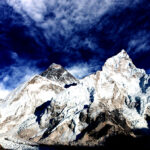
David Neufeld
CanadaIf you are looking for a tour to see the Mt Everest base camp look no further. I have...
Read More...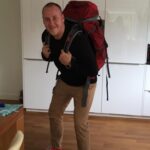
Tim Troost
AustraliaI was looking at an exotic trek adventure. After looking for a bunch of places to go I thought...
Read More...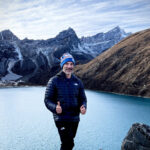
Keith B.
USAKeshab was our most gracious and amiable guide in Kathmandu and to Everest basecamp. My wife accompanied me on...
Read More...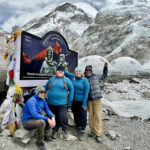
Ken Byers , Nevada
USAMy son and I went for trekking in Nepal in 2009, and we were lucky to have Keshab Khanal...
Read More...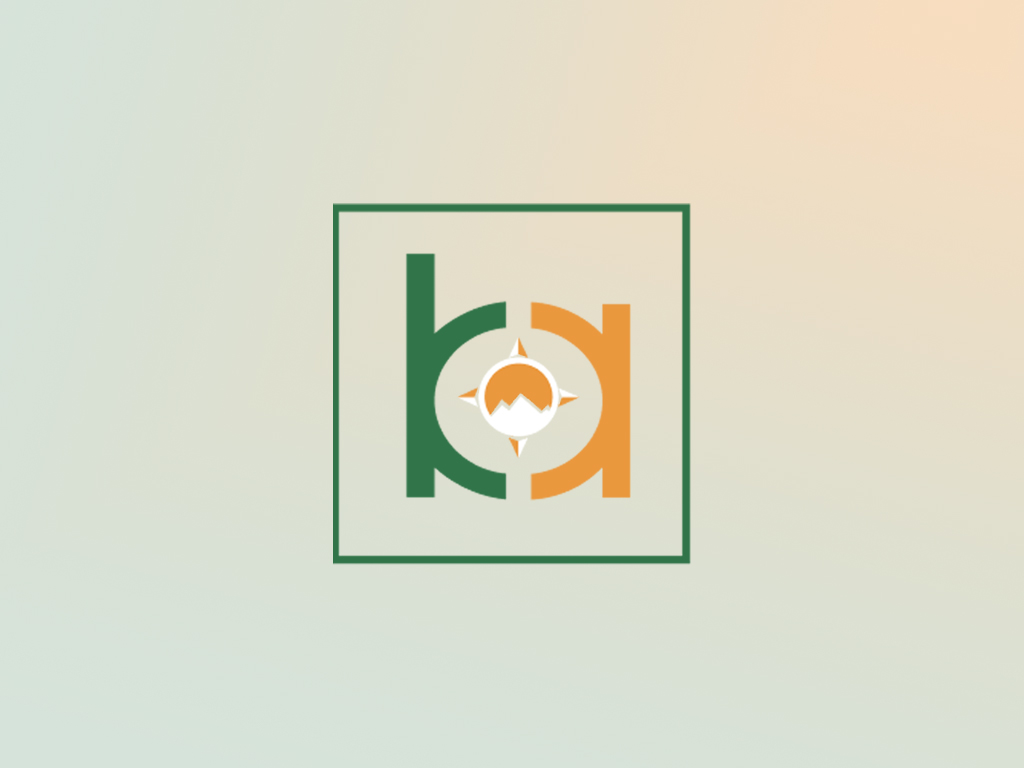
Dr. Raphael Hemmendinger
Jerusalem , IsraelIn 2005 I came to Nepal for the second time, this time whith a very specific queste. I wanted...
Read More...
Richard Rijken
Amsterdam , NetherlandsI was always willing to go to the Himalayas and explore some of the beauties hidden in the sacred...
Read More...
John Peter
Manchester , United KingdomNamaste! This was my first time to Nepal, and I had an amazing time on my trek. From the...
Read More...
David Patrician
Hamburg , GermanyI was on trekking from 24.10.10 to 5.11.10 in the half part of Annapurna circuit from Bhulbhule to Jomsom....
Read More...
Vaya Bairaba
Athens , GreeceEquipment List
Outfit
- Shoes/Boots
- A pair light trekking shoes or sneakers to wear in and about camps or lodge.
- A pair light to medium weight waterproof hiking/trekking boots. Make sure the size and should have to be avoidable for blister.
- At least four pairs of liner socks, synthetic. And three pair heavyweight socks to be worn over liner socks.
- Two pair of trekking pants, preferably that zip on/off at the knees.
- Two pairs of lightweight long underwear.
- Two pairs of nylon hiking shorts.
- A soft shell jacket, water resistant, with insulation, underarm ventilation zippers. The full front zipper is preferable for ventilation.
- Two long sleeve polyesters, light colored shirts for sunny days.
Warmth
- Neck Warmer
- Light weight Down Jacket and Sleeping Bag
- A pair of lightweight socks, a good option for the lower / warmer parts of the trail and also on lodges at the time of dinner.
- A pair liner woolen gloves for mild days and heavy for morning and evening
- Warm wool or synthetic hat
Documents and Money
- Durable wallet/pouch for travel documents, money & passport
- Airline tickets
- Passport and extra passport photos (2 copies)
Electronics
- Additional Batteries Powerbank , Solar Charger
- Additional batteries for Head Lamp
- Head Lamp
Medicine and First Aid
- Sunscreen (SPF 40)
- Lip balm (At least SPF 20)
- Band-aids
- Anti-infection ointments
- Immodium or Pepto bismol capsules for upset stomach or diarrhea
- Extra Strength Excedrin for altitude related headaches
- Ibuprofen for general aches and pains
Miscellaneous but Important
- Toiletries
- Water purification Iodine tablets
- Water bottle/bladder
- UV protective glacier sunglasses – better to have a side shield.
Important Info
Ultimate Guide to Annapurna Base Camp Trek
The Annapurna Base Camp (ABC) trek is a sought-after adventure for trekkers worldwide, combining stunning landscapes, rich cultural experiences, and a moderately challenging trekking route. Here’s your ultimate guide to navigating the ABC trek:
- Accessibility
Annapurna Base Camp is nestled in the heart of the Annapurna Conservation Area. The trek is accessible from Pokhara, a city renowned for its lakeside beauty and proximity to the Annapurna range. The journey to the base camp begins from Nayapul, which can be reached by a 1.5 to 2-hour drive from Pokhara.
How to Get There:
- From Kathmandu to Pokhara: You can fly (25-30 minutes) or take a tourist bus (6-8 hours).
- From Pokhara to Nayapul: Accessible by car or bus, taking approximately 1.5 to 2 hours.
- Difficulty Level
The ABC trek is rated as moderately difficult, making it suitable for both novice and experienced trekkers with good physical fitness. The trek involves daily hikes of 5-7 hours, covering a range of terrain from steep ascents and descents to flat sections.
Preparation Tips:
- Regular cardiovascular exercise and strength training.
- Gradual acclimatization by incorporating rest days.
- Proper gear including trekking boots, layered clothing, and trekking poles.
- Highest Point
The highest point of the trek is Annapurna Base Camp itself, at an altitude of 4,130 meters (13,550 feet). This point offers panoramic views of Annapurna I (8,091 meters), Machapuchare (6,993 meters), and other peaks.
Highlights:
- Sunrise and sunset views over the Annapurna range.
- The proximity to towering peaks providing an immersive mountain experience.
- Connectivity
While trekking, connectivity is generally good in the lower regions. Mobile networks like Ncell and NTC provide decent coverage. Wi-Fi is available at most teahouses, although it becomes less reliable and more expensive as you ascend.
Tips for Staying Connected:
- Purchase a local SIM card in Kathmandu or Pokhara.
- Carry a power bank for charging devices.
- Use messaging apps that work with limited connectivity.
- Driving Road
The road from Pokhara to Nayapul is well-maintained and suitable for vehicles. This road is the main access point for starting the trek.
Road Conditions:
- Paved and accessible year-round.
- Scenic drive with views of lush landscapes and local villages.
- Flight Connection
The nearest airport is in Pokhara, which has frequent flights from Kathmandu. These flights offer spectacular aerial views of the Himalayas.
Flight Details:
- Duration: 25-30 minutes.
- Airlines: Yeti Airlines, Buddha Air, and other domestic carriers.
- Booking: Book in advance during peak trekking seasons (spring and autumn).
- Elevation Guide and AMS (Acute Mountain Sickness)
- Nayapul (1,070 meters / 3,510 feet): Starting point of the trek.
- Ghorepani (2,874 meters / 9,429 feet): Famous for Poon Hill sunrise views.
- Machapuchare Base Camp (3,700 meters / 12,139 feet): Acclimatization stop.
- Annapurna Base Camp (4,130 meters / 13,550 feet): Trek’s highest point.
Preventing AMS:
- Ascend slowly and allow your body to acclimatize.
- Stay hydrated and avoid alcohol.
- Be aware of AMS symptoms: headache, nausea, dizziness.
- Consider carrying Diamox (acetazolamide) for AMS prevention.
- Luxury Options
For those seeking more comfort, several luxury lodges and teahouses provide upgraded amenities. These accommodations offer private rooms, hot showers, and gourmet meals.
Luxury Lodges:
- Ker & Downey Lodges: Known for excellent service and comfort.
- Gurung Lodge: Offers cultural experiences along with luxury.
- Camping Options
While the ABC trek is popular for its teahouse accommodation, camping is also an option for those who prefer it. Campers need to arrange for permits, guides, and porters.
Camping Essentials:
- High-quality tents and sleeping bags.
- Portable cooking equipment.
- Permits and guide arrangements through a trekking agency.
- Heli Ride Options
Helicopter rides to and from Annapurna Base Camp offer a luxurious and quick alternative to trekking. These rides provide an unforgettable aerial view of the Himalayas and are useful for those with time constraints or health issues.
Heli Ride Details:
- Duration: 15-20 minutes from Pokhara to ABC.
- Cost: Varies depending on group size and provider.
- Booking: Can be arranged through trekking agencies or directly with helicopter companies in Pokhara.
Conclusion
The Annapurna Base Camp trek offers a perfect blend of natural beauty, cultural richness, and trekking adventure. With proper preparation and understanding of the trek’s logistics, you can fully enjoy this Himalayan journey. Whether you choose teahouse stays, luxury lodges, camping, or even a heli ride, ABC trek promises a memorable and rewarding experience.
Get Trip PDF file
Why travel with
Broad Adventures
Since 2010, we have curated unique itineraries that offer once-in-a-lifetime experiences, ensuring every trip is filled with joy and adventure. Our focus on the fun factor and the right amount of challenge allows you to achieve a profound sense of personal accomplishment, all while enjoying the camaraderie of like-minded travelers.
Small-Group Adventures
Join an intimate group of like-minded travelers who share your passion for discovering the world's wonders safely and confidently. Our small group settings foster a deeper connection with your fellow explorers and the incredible destinations we visit.
Expert Local Guides
We exclusively employ local guides and porters for their unparalleled knowledge and expertise. Their insights and firsthand experiences enrich your journey, giving you a deeper understanding and appreciation of the local culture, history, and environment.
Responsible for Tourism
Your safety is our utmost priority. Our dedicated team of trained professionals ensures the highest standards of care, including providing fresh and hygienic meals, comprehensive First Aid supplies, and round-the-clock communication services. We are committed to responsible tourism practices, emphasizing the importance of sustainable and ethical travel.
Health and Saftey
Promoting responsible tourism is essential, as it calls for a collective effort from everyone involved in the industry. By prioritizing health and safety, we ensure that each journey is not only enjoyable but also respectful of the destinations and communities we visit.
How can we help you?
- City Tour Equipment
- City Tour Season
- Climbing Equipment
- Climbing Season
- General Questions
- Guide and Staffs
- Nepal Overview
- Tipping
- Transportations
- Trekking Equipment
- Trekking Season
- VISA info
- Weather and Temperature
Do you provide any equipment for the trek?
Broad Adventure provides you a basic equipment like a Sleeping Bag and a down Jacket, for the tea-house trek. And for the climbing trip, we provide the basic equipment. For a camping trek check it once including the section.
What is the time zone of Nepal?
NPT (UTC+05:45)
What cultural attractions can I explore in Kathmandu?
Kathmandu is home to historical sites like Durbar Square, Swayambhunath (Monkey Temple), and Pashupatinath Temple. These landmarks showcase Nepal’s rich cultural and religious heritage, providing visitors with a deep insight into the country’s history.
What are the must-visit cities in Nepal?
Kathmandu, Pokhara, Bhaktapur, and Patan are popular cities offering rich cultural experiences. Each city has its own unique charm, historical sites, and vibrant local markets.
Do you provide any equipment for the trek?
Broad Adventure provides you a basic equipment like a Sleeping Bag and a down Jacket, for the tea-house trek. And for the climbing trip, we provide the basic equipment. For a camping trek check it once including the section.
Do I need to tip the guide and porters? What is the standard tip?
Tips is expected by your team members and normally the standard is 10% of your total trip cost.
What is the climbing season in Nepal?
The main climbing seasons are spring (April to May) and autumn (September to November). During these times, the weather is more stable, providing safer and more favorable conditions for climbing expeditions.
Are there other mountains in Nepal suitable for climbing?
Yes, Nepal is home to numerous trekking peaks and mountains suitable for climbing, such as Island Peak, Mera Peak, and Lobuche East. These peaks offer a challenging yet rewarding experience for climbers of various skill levels.
Can I climb Mount Everest as a tourist?
Climbing Mount Everest requires significant preparation, experience, and permits. Most climbers join organized expeditions with experienced guides. Climbing Everest is a serious undertaking that demands physical fitness, technical skills, and a high level of commitment.
Do I need to tip the guide and porters? What is the standard tip?
Tips is expected by your team members and normally the standard is 10% of your total trip cost.
What is the voltage and plug type used in Nepal?
The standard voltage is 230V, and the plug type is the Europlug (Type C) and the British-style plug (Type D). It’s advisable to bring adapters if necessary.
What is the voltage and plug type used in Nepal?
The standard voltage is 230V, and the plug type is the Europlug (Type C) and the British-style plug (Type D). It’s advisable to bring adapters if necessary.
Is it necessary to get travel insurance for Nepal?
Yes, travel insurance is highly recommended, especially for trekking and adventure activities. Ensure that your insurance covers medical emergencies, evacuation, and trip cancellations.
What languages are spoken in Nepal?
The official language is Nepali, but English is widely understood in tourist areas. Additionally, various ethnic groups have their own languages.
What is the currency used in Nepal, and are credit cards widely accepted?
The official currency is the Nepalese Rupee (NPR). While major cities and tourist areas accept credit cards, it’s advisable to carry cash in remote areas. ATMs are available in urban centers.
How can I get around within cities in Nepal?
Transportation options include taxis, rickshaws, and local buses. Walking is also a great way to explore the cities, especially in the old quarters. Many cities have well-preserved historic areas, and navigating them on foot allows for a more immersive experience.
What cultural attractions can I explore in Kathmandu?
Kathmandu is home to historical sites like Durbar Square, Swayambhunath (Monkey Temple), and Pashupatinath Temple. These landmarks showcase Nepal’s rich cultural and religious heritage, providing visitors with a deep insight into the country’s history.
Can I climb Mount Everest as a tourist?
Climbing Mount Everest requires significant preparation, experience, and permits. Most climbers join organized expeditions with experienced guides. Climbing Everest is a serious undertaking that demands physical fitness, technical skills, and a high level of commitment.
Are permits required for trekking in Nepal?
Yes, trekking permits are required for most trekking regions. The type of permit depends on the specific trekking area. It’s important to obtain the necessary permits from the respective authorities to support local conservation and management efforts.
When is the best season for treks in Nepal?
From March to mid-June and September to December is the best season for treks.
What is the fitness required for the treks?
Generally, to trek in Nepal we should have good physical and health conditions. And also able to walk 4- 7 hours in day at a high altitude with your little backpack.
Do you pick me up at the Airport upon my arrival?
Yes, our airport representative welcomes you at the airport and transfers you to the hotel in a private tourist vehicle.
Does my guide/porter speak English?
They speak English. All the guides are professional and due to their professionalism, they speak good English. The guide’s English is enough to explain the local culture, activities, and religions.
Are the treks and tours secured? What about the security?
Providing security to our clients is our principal. The government-licensed holder guides and other crew members are carefully assigned for your trip. Even though, would like to counsel you to take care of your equipment, and bags. If you doing a tea-house trek your accommodation is in a local guesthouse, where you have to be a precaution yourself at all times. And if you are on a camping trek always keep your bags inside the tent and while at nighttime please keep your bag in the middle of the tent. The camping leader assigns a Sherpa as a guard throughout the nighttime.
What sort of ground transportation do you use?
Normally we assign a car for up to 2 people and a Jeep for up to 5 people and then a bus for up to 14 PAX and Coster and Sutlej Bus depending on group size. There are some trekking routes, which are dirt roads for them we assign 4WD Jeeps. It also depends on what services you opt for.
Are the staff insured by your company?
Yes, all of the staff and crew members are insured.
Should I need to join the group?
Joining a group depends on your booking and the option that you choose. If you have booked for Private Trip then obviously you will not join. Otherwise, normally the same trip departs on the same day then the group will join.
Do you arrange a private trip?
Yes, of course, we will arrange a private tour.
How big is a group size?
We will try to arrange a small group of willing people, which immortalize the treks. Normally we encompass 12 -16 people in a group. (This is not to apply to those who want to do a Private Trip, no minimum and maximum for them.)
Is the drinking water okay? Or do I need to use tablets?
For drinking water you can buy bottled water and purified mineral water on tea-house treks and city tours. And in the camping trek, the camping cook provides you with boiled water. For some cases of remote area trekking it would be better to have some purification tablets that you can buy in Kathmandu.
What are the accommodations and meals like?
All the meals that you provided are hygienic and fresh. While you are on a camping trek you get meals prepared by a professional camping cook. And if you are doing a tea-house trek you will get the main course as like in the cities. For accommodation on the camping trek, you will have a tent with good-quality mattresses and a sleeping bag. And if you are on a tea-house trek you will normal twin-sharing room with basic facilities with a warm mattress and blanket, and also we provide a sleeping bag if you need it.
Is the shower facility during the tour/trek?
Yes, you can have a shower during the trek. In the camping trek, you will get a shower in a shower tent which is provided 3-4 times in the whole trek, depending on the duration of the trek. And in a tea-house trek, we will provide you attached room where possible and for the rest of town, you will pay for a shower.
Do you provide any equipment for the trek?
Broad Adventure provides you a basic equipment like a Sleeping Bag and a down Jacket, for the tea-house trek. And for the climbing trip, we provide the basic equipment. For a camping trek check it once including the section.
Is there any possibility of communicating in my hometown?
Yes, you can. In the Everest and Annapurna regions, you can connect via Phone, or Internet both available in most of the town and, in some remote routes, you may need to use a satellite phone that is carried by your trek guide or also get in the local town.
Can I charge the batteries of cameras, and phones?
Yes, you can charge your devices, but recommended you bring your plugs, and chargers and also do not leave unattended anything while charging in a lobby or somewhere in the trekking guesthouse. And if you are on a camping trek it’s quite hard to charge the phone so we advise you to bring a portable charge.
Are there any health precautions I should take before traveling to Nepal?
Vaccinations for diseases like typhoid, hepatitis, and tetanus are advisable. Altitude sickness prevention measures should be considered for high-altitude treks.
How can I find a reliable trekking guide in Nepal?
Reliable guides can be found through licensed trekking agencies, recommendations from fellow travelers, or by checking with the Nepal Tourism Board. Ensure that your guide has the necessary permits and is experienced in the chosen trekking region
Is hiring a local guide recommended for exploring Nepal?
Yes, hiring a local guide is highly recommended, especially for trekking and exploring remote areas. Guides provide valuable insights into the culture, history, and geography of the region, ensuring a safer and more enriching experience.
Is hiring a local guide recommended for exploring Nepal?
Yes, hiring a local guide is highly recommended, especially for trekking and exploring remote areas. Guides provide valuable insights into the culture, history, and geography of the region, ensuring a safer and more enriching experience.
Is Nepal a safe country for tourists?
Yes, Nepal is considered safe for tourists. However, like any travel destination, it’s essential to follow common-sense safety practices and stay updated on travel advisories. Local people are welcoming, and the country values its reputation as a safe and friendly destination.
What is the best time to visit Nepal?
The best time to visit Nepal is during the spring (March to May) and autumn (September to November) seasons when the weather is generally favorable for outdoor activities. During these periods, the skies are clear, and the temperatures are moderate.
What makes Nepal a popular tourist destination?
Nepal is renowned for its stunning Himalayan landscapes, rich cultural heritage, diverse wildlife, and warm hospitality. The country offers a unique blend of adventure, spirituality, and natural beauty.
What is the standard tip?
Tipping is subjective so it depends on your satisfaction. However, the standard is about 20% of the trip cost you can share with the staff.
Do I need to tip the guide and porters? What is the standard tip?
Tips is expected by your team members and normally the standard is 10% of your total trip cost.
Do you provide any equipment for the trek?
Broad Adventure provides you a basic equipment like a Sleeping Bag and a down Jacket, for the tea-house trek. And for the climbing trip, we provide the basic equipment. For a camping trek check it once including the section.
Are permits required for trekking in Nepal?
Yes, trekking permits are required for most trekking regions. The type of permit depends on the specific trekking area. It’s important to obtain the necessary permits from the respective authorities to support local conservation and management efforts.
Do I need a guide for trekking in Nepal?
While it’s not mandatory, hiring a local guide is highly recommended for safety, navigation, and cultural insights. Guides are familiar with the terrain, can provide valuable information about the region, and ensure a smoother trekking experience.
What are the most popular trekking destinations in Nepal?
The Everest Base Camp trek, Annapurna Circuit, Langtang Valley trek, and Manaslu Circuit are among the most popular trekking routes in Nepal. Each trek offers unique experiences, from breathtaking mountain views to encounters with diverse cultures.
When is the best season for treks in Nepal?
From March to mid-June and September to December is the best season for treks.
Do I need to tip the guide and porters? What is the standard tip?
Tips is expected by your team members and normally the standard is 10% of your total trip cost.
Can I extend my tourist visa to Nepal?
Yes, tourist visas can be extended at the Department of Immigration in Kathmandu or the Immigration Office in Pokhara. Extension fees and requirements vary, and it’s advisable to initiate the process a few days before the current visa expires.
What documents are required for a tourist visa on arrival?
Passport with at least six months validity, a completed visa application form (available at the airport), and two passport-sized photos are required. Additionally, visa fees must be paid in cash (USD or equivalent).
What are the types of visas available for tourists?
Tourist visas are available for duration ranging from 15 to 90 days. Extensions can be obtained within Nepal if needed. Other visa categories include business visas, student visas, and diplomatic visas, each with specific requirements.
How do I obtain a visa for Nepal?
Tourist visas for Nepal can be obtained upon arrival at Tribhuvan International Airport in Kathmandu or at various land entry points. Alternatively, you can apply for a visa at the Nepalese embassy or consulate in your home country before traveling.
What is the monsoon season in Nepal?
The monsoon season in Nepal runs from June to early September. During this time, the country receives heavy rainfall, particularly in the southern plains and the hilly regions. The monsoon brings lush green landscapes but can also cause landslides and flooding in some areas.
What is the time zone of Nepal?
NPT (UTC+05:45)

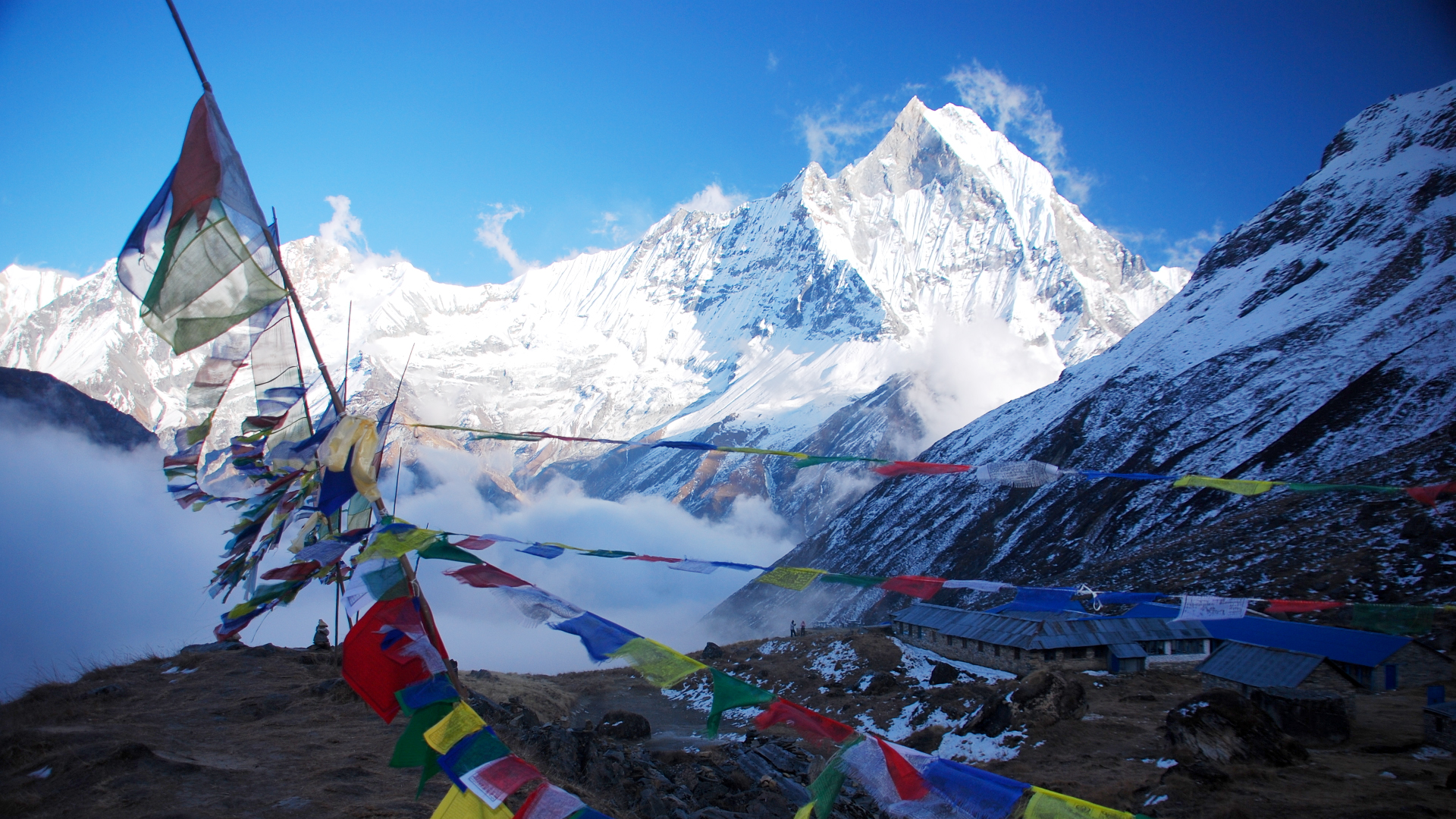
 Group Size: 1-15 PAX
Group Size: 1-15 PAX  Duration: 15 Days
Duration: 15 Days  Trip Start: Kathmandu
Trip Start: Kathmandu  Trip End: Kathmandu
Trip End: Kathmandu  Average Dist. per Day: 12KM
Average Dist. per Day: 12KM  Average Time per Day: 6hrs
Average Time per Day: 6hrs  Trip Grading: Moderate
Trip Grading: Moderate 